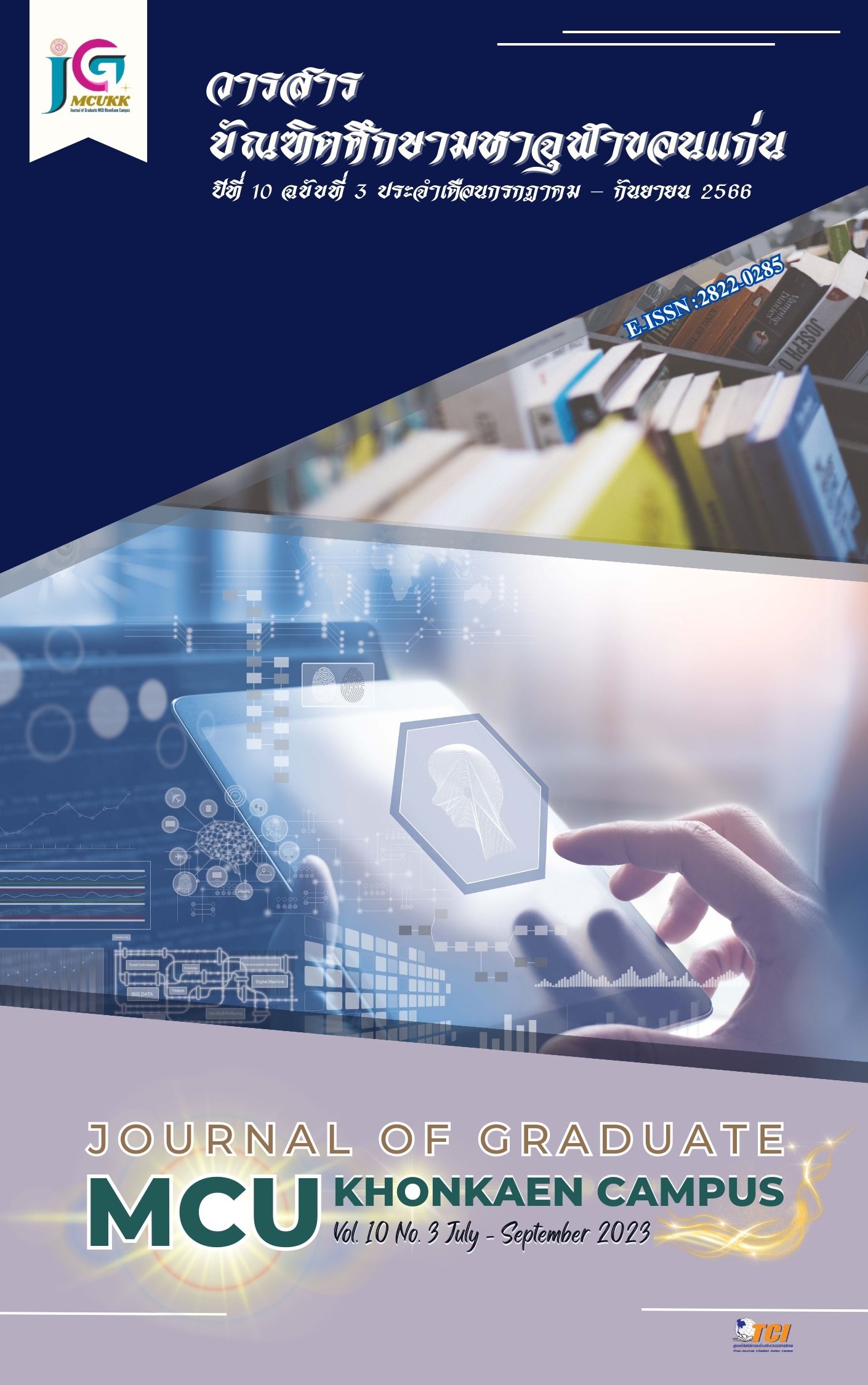The Relationship Between the 21st Century Leadership of School Administrators and Teachers Working Morale and Encouragement in Schools Under Kanchanaburi Primary Educational Service Area Office 3
Main Article Content
Abstract
The research aimed to study the 21st century leadership of school administrators, teacher working morale and encouragement, and the relationship between the 21st
century leadership of school administrators and teachers working morale and encouragement in schools under Kanchanaburi Primary Educational Service Area Office 3.
The sample consisted of 288 teachers in school under Primary Educational Service Area Office 3 obtained by stratified random sampling according to school size.
A constructed five-level rating scale questionnaire with content validity between 0.67-1.00 and reliability of 0.97 as a tool for data collection. The statistics used for data analysis were percentage, mean, standard deviation, and Pearson's product moment correlation coefficient with a statistical significance level at 0.05.
The findings were as follows:
1. The 21st century leadership of school administrators in schools under Kanchanaburi Primary Educational Service Area Office 3 was overall and in each individual aspect were at a high level.
2. The teacher working morale and encouragement in schools under Kanchanaburi Primary Educational Service Area Office 3 was overall and in each individual aspect were at a high level.
3. The relationship between the 21st century leadership of school administrators and teacher working morale and encouragement in schools under Kanchanaburi Primary Educational Service Area Office 3 overall had a high positive correlation.
Article Details

This work is licensed under a Creative Commons Attribution-NonCommercial-NoDerivatives 4.0 International License.
References
จิรัชญา ชัยชุมขุน. (2564). ภาระงานล้น แต่เงินน้อย สรุปปัญหา ทำไมครูไทยอยากลาออกเมื่อครูถูกผลักให้เป็นผู้เสียสละ. สืบค้นเมื่อ 24 เมษายน 2566, จาก https://thematter.co/social/education/why-thai-teachers-wanna-quit/160415
ชูศรี วงศ์รันตนะ. (2553). เทคนิคการใช้สถิติเพื่อการวิจัย (พิมพ์ครั้งที่ 12). กรุงเทพฯ: ไทเนรมิตกิจ อินเตอร์โปรเกรสซิฟ.
ปฏิพัทธ์ ใจดี. (2558). ขวัญและกำลังใจในการปฏิบัติงานของครูโรงเรียนดัดดรุณี จังหวัดฉะเชิงเทรา สังกัดสำนักงานเขตพื้นที่การศึกษามัธยมศึกษา เขต 6. (วิทยานิพนธ์การศึกษามหาบัณฑิต). ชลบุรี: มหาวิทยาลัยบูรพา.
ผ่องพรรณ พลราช. (2560). ภาวะผู้นำของผู้บริหารสถานศึกษาในศตวรรษที่ 21 สังกัดสำนักงานเขตพื้นที่การศึกษามัธยมศึกษาเขต 29. (วิทยานิพนธ์ครุศาสตรมหาบัณฑิต). อุบลราชธานี: มหาวิทยาลัย
ราชภัฏอุบลราชธานี.
มาซีเต๊าะ บีมา. (2559). ความสัมพันธ์ระหว่างภาวะผู้นำการเปลี่ยนแปลงของผู้บริหารสถานศึกษากับขวัญ และกำลังใจในการปฏิบัติงานของครู สำนักงานเขตพื้นที่การศึกษาประถมยะลา. (วิทยานิพนธ์ครุศาสตรมหาบัณฑิต). ยะลา: มหาวิทยาลัยราชภัฎยะลา.
วิจารณ์ พานิช. (2555). วิถีสร้างการเรียนรู้เพื่อศิษย์ในศตวรรษที่ 21. กรุงเทพฯ: มูลนิธิสดศรีสฤษดิ์วงศ์.
วิโรจน์ สารรัตนะ. (2556). กระบวนทัศน์ใหม่ทางการศึกษากรณีทัศนะต่อการศึกษาศตวรรษที่ 21 กรุงเทพฯ: ทิพยวิสุทธิ์.
สำนักงานเขตพื้นที่การศึกษาประถมศึกษากาญจนบุรี เขต 3. (2565). บริบทการจัดการศึกษาสำนักงานเขตพื้นที่การศึกษาประถมศึกษากาญจนบุรี เขต 3. กาญจนบุรี: สำนักงานเขตพื้นที่การศึกษาประถมศึกษากาญจนบุรี เขต 3.
สำนักงานเลขาธิการสภาการศึกษา. (2560). แผนการศึกษาแห่งชาติ พ.ศ. 2560 - 2579. กรุงเทพฯ: พริกหวานกราฟิค.
สำนักงานสภาพัฒนาการเศรษฐกิจและสังคมแห่งชาติ. (2565). ร่างแผนพัฒนาเศรษฐกิจและสังคมแห่งชาติ ฉบับที่สิบสาม พ.ศ. 2566-2570. กรุงเทพฯ: สำนักงานสภาพัฒนาการเศรษฐกิจและสังคมแห่งชาติ.
อรวรรณ ภัทรดำเนินสุข. (2564). ภาวะผู้นำการเปลี่ยนแปลงของผู้บริหารกับแรงจูงใจในการปฏิบัติงานของครูในสถานศึกษา สังกัดสำนักงานเขตพื้นที่การศึกษาประถมศึกษาสมุทรสงคราม. (วิทยานิพนธ์ศึกษาศาสตรมหาบัณฑิต). นครปฐม: มหาวิทยาลัยศิลปากร.
Best, J. W. (1981). Research in education. (4th ed.). Englewood Cliff: Prentice Hall.
Krejcie, R. V., & Morgan, D. W. (1970). Determining sample size for research activities. Educational and Psychological Measurement, 30(3), 607-610.

